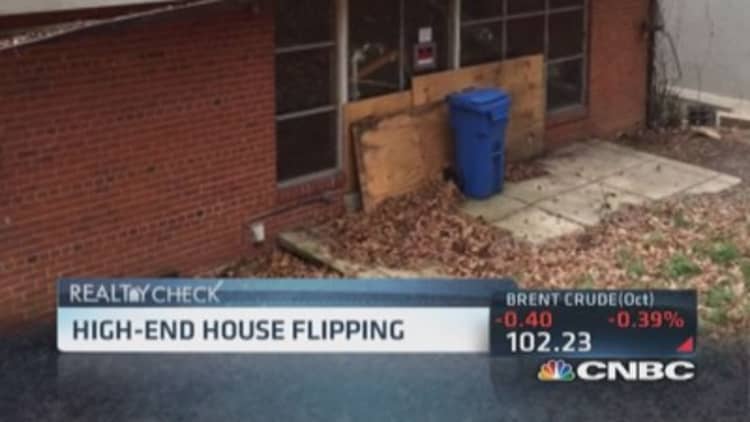
It is dirty, financially risky and potentially dangerous work, but depending on the current direction of the housing market, it can be highly profitable. But home "flipping," defined as buying and selling a home within a short period of time for the sole purpose of making money, is now on the slide.
Home prices rose dramatically last year and are now easing, leaving a very small margin for flippers.
"Home flipping is settling back into a more historically normal pattern after a flurry of flipping during the recent run-up in home prices in 2012 and 2013," said Daren Blomquist, vice president at RealtyTrac. "Flippers no longer have the luxury of 20 to 30 percent annual price gains to pad their profits. As the market softens, successful flippers will need to focus on finding properties that they can buy at a discount and efficiently add value to."
So now many are looking to high-end neighborhoods to reap big profits.
Real estate agent Christal Goetz and her contractor husband, Eric, found a home in a sought-after northwest Washington, D.C., location in January. The four bedroom, three bath house was nothing short of a disaster inside, so they got a good deal, paying about $535,000 for it.
"We definitely look for location, it has to be a great location where we know it's going to be in high demand," said Christal. "We look for good bones to the structure, but also what can make it really unique and interesting."
They put thought, design and about $250,000 into the 2,600-square-foot home and listed it for $925,000. Today it is under contract at the asking price.
"It's like any business really. Do you go after the small individual clients where you have to do a hundred accounts, or do you go after, as I say in the business world, the 'white whale,' where you're getting five or six clients but your profit margin is higher," reasoned Christal.
Read More Where you give up the most to afford a house
Still, as home price gains are easing nationwide, overall flipping is down.
Flippers represented 4.6 percent of all U.S. single-family home sales in the second quarter of this year, down from 5.9 percent in the first quarter of 2014 and down from 6.2 percent in the second quarter of 2013, according to RealtyTrac.
The average gross profit of $46,000 per flip, a 21 percent return, was down from 31 percent a year ago, which was the peak since RealtyTrac began looking at this segment of the market at the beginning of 2011.
High-end flipping, however, is heating up. Flips with a sale price of $750,000 or more rose 21 percent from a year ago, while homes priced below $400,000 declined as a share of all flips from a year ago, according to RealtyTrac. Homes priced between $750,000 and $1 million had a 41 percent return, which explains why flippers are heading to higher-priced neighborhoods.
Markets with the best return on flips in the second quarter included Pittsburgh (106 percent), New Orleans (76 percent), Baltimore (73 percent), Virginia Beach, Virginia, (66 percent) and Daytona Beach, Florida (63 percent). Metro areas with the highest dollar amount of average gross profit on home flips included San Jose, California, Washington, D.C., San Diego, Los Angeles and Seattle, all of which had an average gross profit of more than $100,000 per flip, according to RealtyTrac.
Read MoreLate-payment rate on US mortgages declines in 2Q
Flipping is definitely getting harder, as there are fewer distressed properties for sale. Prices may be easing, but they're still rising because supplies are low.
"The secret to flipping houses is getting the property to be at a great price, and there's just very, very few properties in our area at low prices," said David Fogg, a real estate agent in Burbank, California.
The Goetzes say it's all about quality—the location and the renovation. They currently have three other houses that they are in the process of flipping.
—By CNBC's Diana Olick, with data visualization by CNBC's John W. Schoen.


